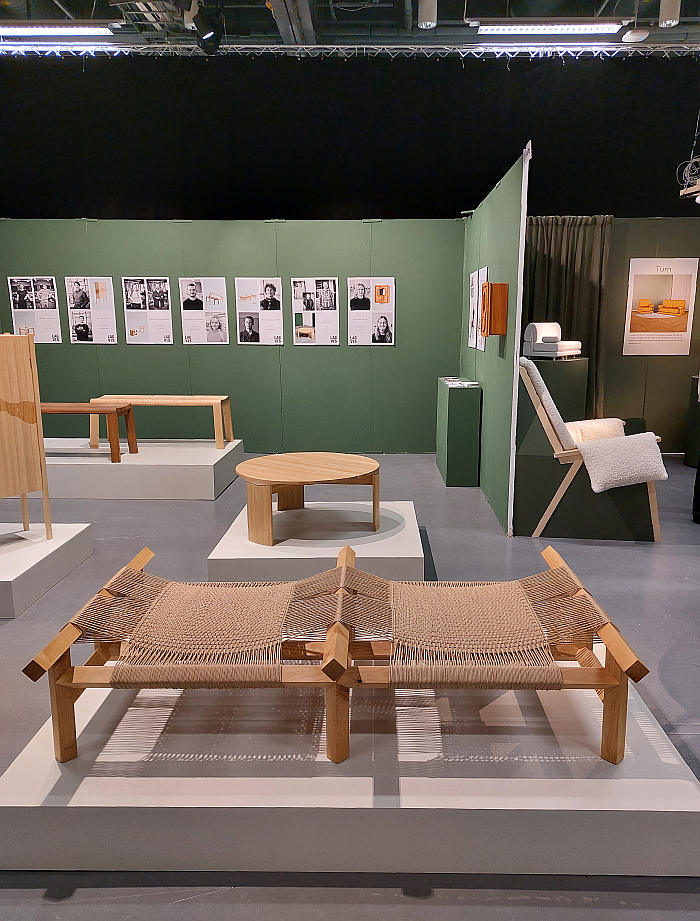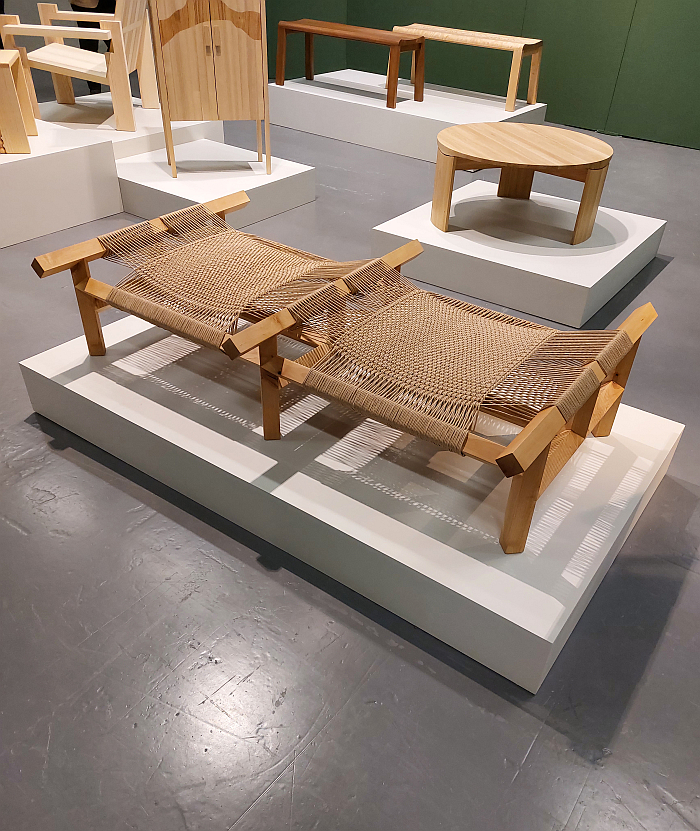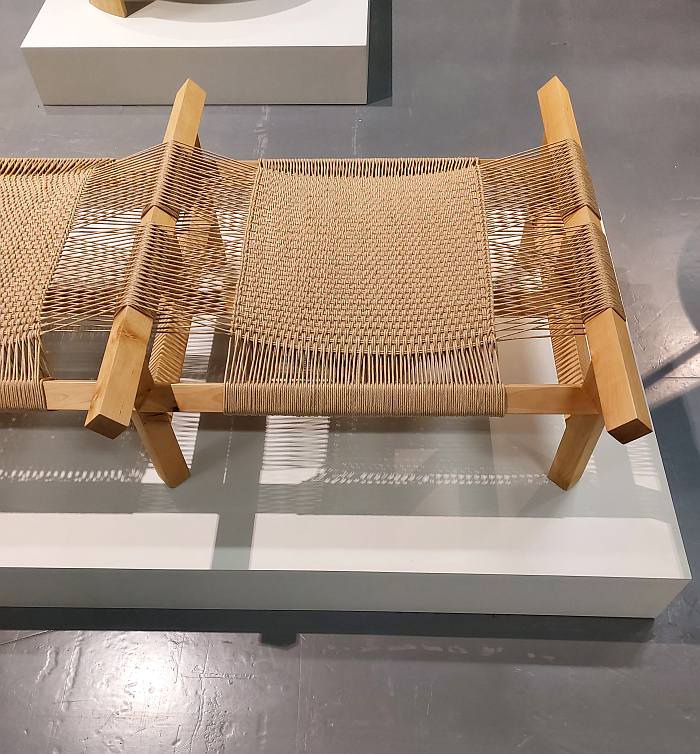
Woven cord of various types is a common material in furniture, has been used for generations, centuries, has more than proven its worth over those generations, centuries, not only as a structural material but as an aesthetic material and as an ambient material; however, when used woven cord is, invariably, used as a component of an object, as a means of providing a particular functionality, most probably a seat or storage option. And more often than not the woven cord is an interchangeable material, any one of several alternative materials could be employed for that function. Only very rarely in furniture design is woven cord the object.
Why? Why not employ woven cord in the foreground, as the starting point of a furniture object, as the irreplaceable essence of the project?
A question the Verpa benk realised by Oslo based designer Bjørn van den Berg in conjunction with furniture maker Leon Moen Aaserud, not only poses but admonishes we all approach.

Arising in context of the annual Lagvis platform, a project led by the Craft Centre at the Edvard Munch Academy, Oslo, 😱 ... sorry, that was unnecessary... that brings designers and crafters together with the aim of developing joint projects that benefit not only both protagonists, but design, craft and the environments we all exist in, a cooperative creative concept found in a great many forms around the world and which regularly produce interesting results, the first thing that strikes you about the Verpa benk is its scale, that it exists at a much, much, larger scale than most all other contemporary furniture. Not an unpleasant scale, far from; rather one that tends to question why all furniture doesn't exist at such a scale. Why the recalcitrance to produce furniture with a volume that makes it as much a space in itself as a piece of furniture to be used in a space? An approach to furniture design, arguably, practised by the likes of a Verner Panton, in materials and forms very different to those of Bjørn and Leon, but with the same probing inquiry of interiors, of the use of interior spaces.
A work in Norwegian black alder and paper yarn that also poses questions of its raison d'etre, its function. Yes, the word 'benk' in its name does imply it is a bench, but standing in front of it, whereby the question of 'front' also needs to be clarified, but standing in 'front' of it in Stockholm Furniture Fair's Greenhouse, that curated place within Stockholm Furniture Fair for nurturing and hardening of students, professional designers taking their first steps and fledgling brands seeking to establish themselves, was also to understand that it could be table, a sofa/side table more than dining table, not least on account of the height; although that said, possibly a table around which one can lounge and socialise, there is something ancient and vernacular in it, something that implies an object from a time before contemporary seating and interiors and socialising conventions. Not that Verpa is a work of the past, it is very much a work for the future, potentially a proposed future that may never come, see again Panton, or Nanna Ditzel, that contemporary of Panton, and unfairly overlooked Danish born re-definer of space, whose 1961 Floating Dock concept, a demand for a return to the age of lounging, Verpa could compliment as a material, structural and formal counterpoint.
Thoughts on Verpa as a table for lounging that highlight that the scale does mean you need a space that can accommodate it: Verpa is not an object for a compact apartment. Which may answer the question we posed above about the recalcitrance to produce objects at such scale. Or at least the commercial recalcitrance, designers can work at whatever scale they want. In many regards that is one of the functions of designers to ignore convention in order to image the impossible that can inform the eventual. See, again, Panton and Ditzel. Nor is it an object we'd like to see at a smaller scale, it needs to be at the scale it is.
A scale that is appropriate, and returning to it's proposed intended use as benk, for use in public/commercial interior spaces, for example, public seating in a museum or a hotel/office lobby, somewhere to quickly rest or to wait for others; a pubic space where the strict visual separation maintains a degree of privacy, defines borders. A strict visual separation that both reminds of the importance of the repeating quadrat in the (hi)story of architecture, and that, potentially, Verpa could, possibly, be available in other lengths. Possibly even at half its current length.
And a scale that is also appropriate for any and every domestic interior space large enough to accommodate it and where, for example, with the addition of some blankets and cushions you can create a space in which to exist safely and securely isolated from the world around you, while being part of that world whenever you choose to be; or you can employ it as a platform on which to sit cross-legged, assuming that it is your body still allows you to achieve that position, to read and/or work, thoughts which also allow one to locate Verpa in a contemporary home office, as does thoughts on Verpa as a low-down laptop/tablet table for floor level working; or employ it in a vestibule/porch as an impromptu seating/storage option. Again, if that vestibule/porch has appropriate dimensions. Or as the centre piece of a public room akin to a sofa, but with a very different attitude and function and relationship to and from and with a sofa. A seating object that creates a public room very different to the contemporary living room. Which brings us back to it being an object from a time before contemporary conventions. And an object for future conventions.
And a comparison with a sofa that highlights that you can't lie down on Verpa, or not without some form of cushioning, or being some sort of stereotypical Indian fakir, or being a baby wombat, or without hurting yourself: the turning of the wooden struts, beams, that form the frame through an angle of 45 degrees not only defining the visuals of the work, visuals whose defence and challenge stand diametrically juxtaposed to the serenity of the work, to its evenness of temperament when in its immediate vicinity, and that thanks, we'll argue to the primacy of the woven paper yarn, nor only necessitating some carpentry joints rarely seen in furniture and which make a case for their more regular appearance, but is also, if we've understood correctly, structurally important, enabling the tautness of the paper yarn, enabling the paper yarn to be woven over such an expanse with the necessary stability and robustness. Enabling the paper yarn to be the object rather than a feature of an object. We can't imagine that would be possible, that you'd get the necessary stability and tautness, if you used the wood conventionally positioned with flat horizontal and vertical surfaces, we imagine you need the angles, the angularity that contradicts the organity of the work. But we could be wrong. We're not civil engineers and we spoke to neither Bjørn nor Leon about it, but that's our assessment. For what it's worth.
And turned struts, beams, connected via rarely seen furniture joints that also, potentially, imply why woven cords don't take on a primacy more often in furniture design: it requires an alternative approach to carpentry, involves rethinking how furniture objects are constructed and their visual appearance. Regular impediments to developments in furniture and interiors.

We sadly didn’t get the chance to sit on Verpa and so can't say anything about the seating comfort or stability, or indeed the ease and security with which it can be used as a table, nor did we employ it over a great many years, thereby enabling us to comment on its durability, which, obviously are all important issues.
Or at least are important issues with Verpa as a product; however, with Verpa as a proposal, as a thinking aloud about furniture and interiors, as a thinking aloud about contemporary and future relationships between craft and design, about the use of woven cord in furniture, about woven cord as a material from the distant past that could be a meaningful material for the future, issues of secondary importance. And that was very much how we approached and engaged with Verpa: as a proposal, a proposition, a question, a questioning.
Which isn't to rule out that it won't become a product, all it takes is a distributor with the bravery and vision to take it on. Yes, such are very rare beasts in a contemporary furniture industry that has barricaded itself in its comfort zone, but can be located, do exist.
For our part we were delighted to make its acquaintance and are looking forward to seeing how the Verpa benk develops, as a product and as concept and as a question.
Further information on Bjørn van den Berg can be found at www.bjornvandenberg.no
And more information on Lagvis, including details of all projects realised, of which there are and were other very interesting ones, can be found at www.lagvis.no
We can't find any information on Leon Moen Aaserud, other than he may be a student/recent graduate of the Hjerleid Handverksskole, in Dovre, central Norway, should that change we will update.